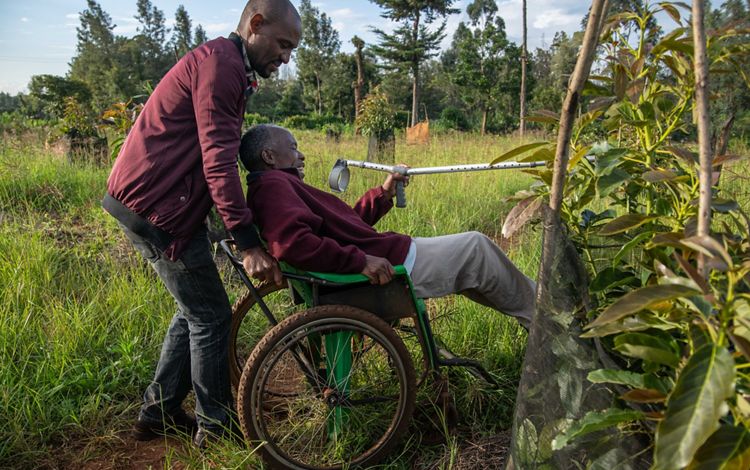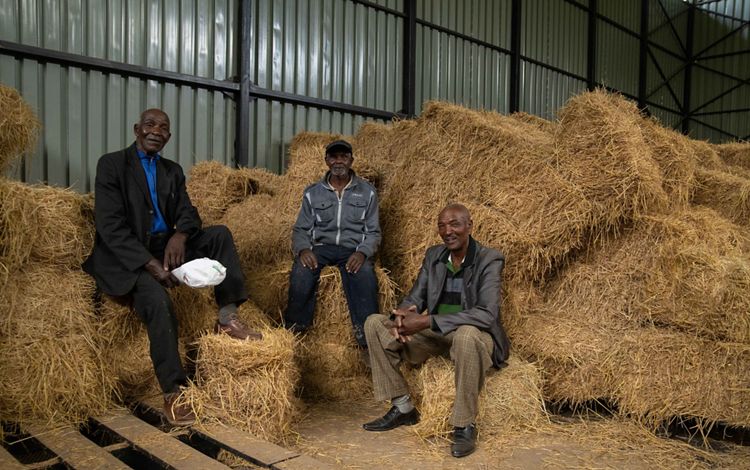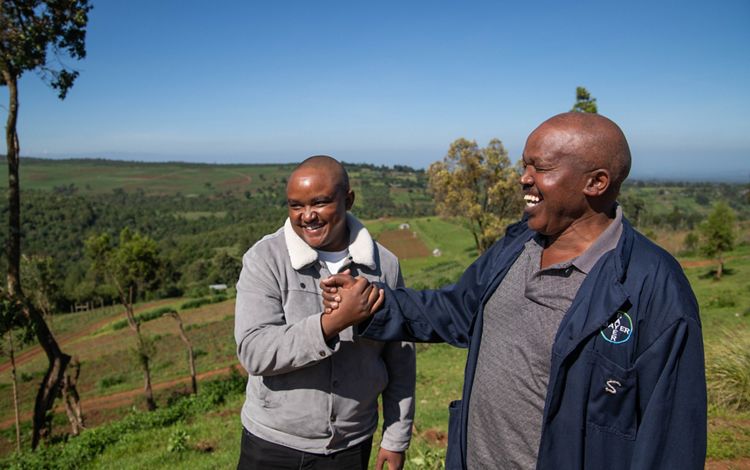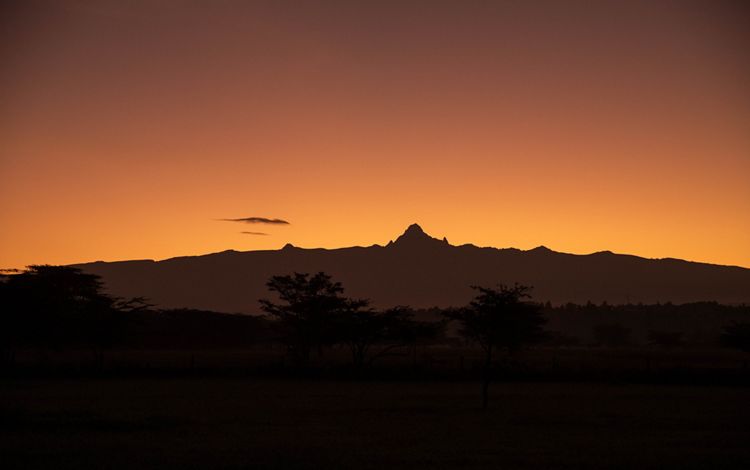
Creating a Regenerative Foodscape in Kenya
The CHEF Program is coordinating agricultural efforts across central Kenya for maximum sustainability
John Maina walks through the door of his small, screened-in plant nursery. The sky behind him is a vibrant blue and here, just a few miles from where an official sign marks the equator, the early morning sun already feels hot against the skin.
He sits down on a low chair and carefully whittles away at the top of a small seedling. Carefully, he takes what looks like an identical stem, fits it into the carved seedling stem like two jigsaw puzzle pieces, and ties them together with twine.
John has just grafted a small piece of branch, called a scion, from a mature Hass avocado tree growing on his farm onto the root stalk from an indigenous variety. By doing this, a farmer gets all the agricultural benefits of planting an indigenous avocado tree, such as it being more drought- and pest-resistant, along with the economic benefits of taking the more popular Hass avocado fruit to market.
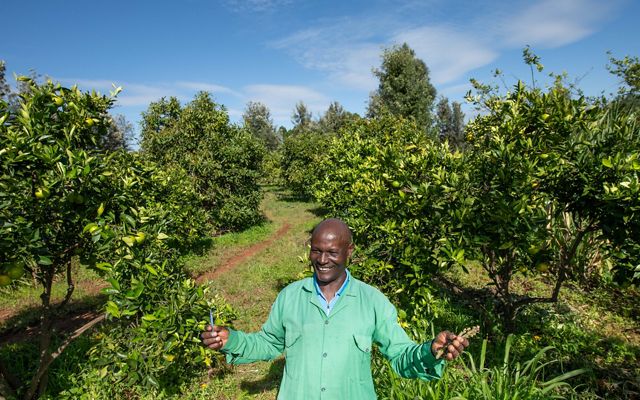
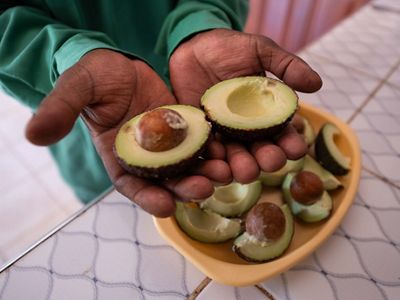
But these grafted seedlings aren’t for John to add to his collection of more than thirty avocado trees on his farm. After three months of growth, he plans to sell them to local farmers for 150 Kenyan shillings a piece (about $1.15).
John is a member of the Laikipia Avocado Outgrower’s Community-Based Organization and is one of five farmers selected for support in seed entrepreneurship. With training and start-up supplies from Micro Enterprises Support Programme Trust (MESPT) and KEITT Exporters, along with the opportunity to sell his crops back to KEITT for export, John’s farm is a perfect example of how a new TNC initiative called CHEF is bringing partners together coordinate agricultural efforts across the region to address threats from climate change, extractive agriculture, and land degradation.
Quote: John Maina
They took us to the class [on grafting], we learned how to do it, and now we are ready to do it on our own.
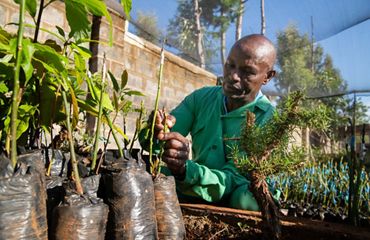
What Is CHEF?
The Central Highlands Ecoregion Foodscape, or CHEF, is an ambitious effort with a broad set of partners to transform the region into a regenerative foodscape where food production practices can actually help improve the health of soil and water supplies while also supporting biodiversity conservation.
Kenya’s Central Highlands features a range of interconnected and interdependent habitats. Water flows from Mount Kenya, the second highest peak in Africa, through highland forests and farmland, to the rangelands where livestock and wildlife search for grass.
“CHEF is not just important to TNC, but it is important for so many partners,” says TNC’s Africa Agricultural Director Michael Misiko. “It aligns so many partners to solve a critical problem— the problem of fragmentation.”
From Mountains to Grasslands
Mountain Foot Farm is just as the name suggests: at the foot of a mountain. The snow-covered peak of Mt Kenya stands silently overlooking the farm. Samson Kithinji and his son Dennis Kithinji run the farm together, where they grow potatoes, snow peas, sugar snap peas and other crops.
Lucas Ouma Odongo from KEITT Exporters visits this farm frequently and provides critical technical support, such as what crops to plant, what fertilizers to use, and advice rotational cropping. KEITT picks up the farm’s harvest of peas twice a week and trucks them to Nairobi where they are packed and shipped to Europe and Dubai. Previously, Mountain Foot Farm worked with an exporter who only bought from them a few months of the year, but now they have a guaranteed stable buyer all year round.

Further downstream, CHEF is working with the Matanya Hay Growers Cooperative on a hay storage initative. Here, farmers are incentivized to grow grass, which, once dried, can be stored in a brand-new hay shed for a small fee. Then, in times of drought, pastoralists are able to purchase nutrient-rich hay for their livestock—a source of income for the farmers and a lifeline for the cattle.
In addition to fluctuating rainfall, some rangelands communities are dealing with the spread of an invasive cactus—the Englemann prickly pear (opuntia engelmannii)—that has taken over grazing lands and reduces the amount of available forage. With the support of CABI, the CHEF program has trained over 200 community members on sustainably controlling the spread of the cactus, including through introducing a sap-sucking insect called a cochineal that was provided by neighbor and TNC partner Loisaba Conservancy. In addition, TNC is training select community members on use drone technology to monitor the efforts.
CHEF is also tackling water management throughout the system. The Centre for Training and Integrated Research in ASAL Development (CETRAD) is installing water meters to farmers and other water users in order to strengthen water governance and promote equitable water access.
In this truly interconnected landscape, the CHEF program is bringing cohesion and community into solving complex challenges.
More Images From the CHEF Program
